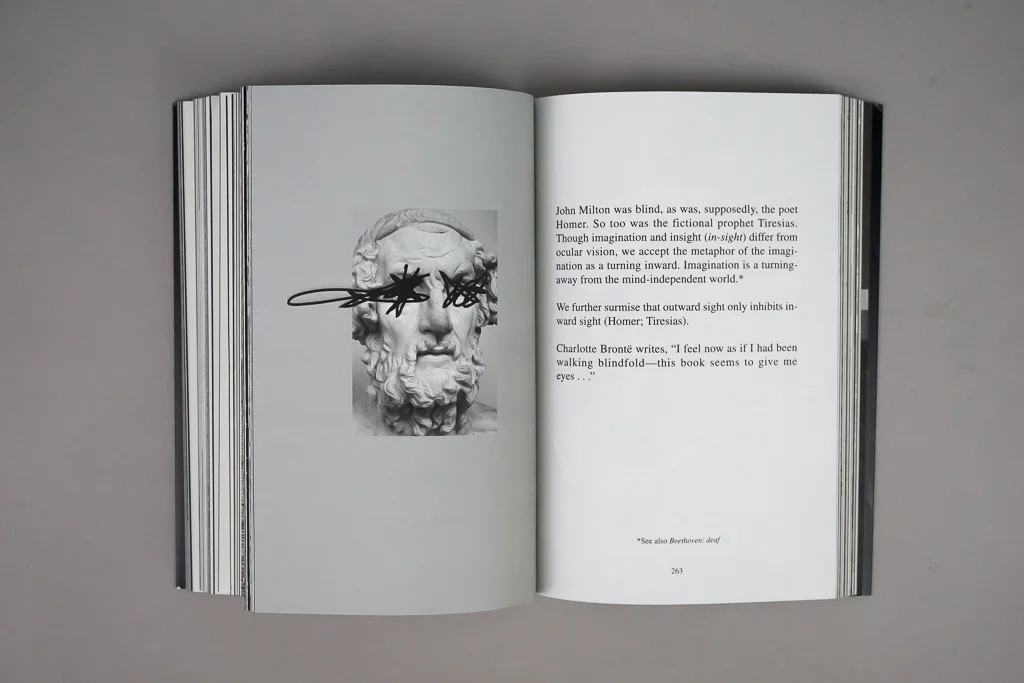What We See When We Read - Peter Mendelsund
What We See When We Read is a fully illustrated exploration of what humans see while we are reading. It focuses on how we visualize the narrative, characters, and our senses while reading fiction. Written by Peter Mendelsund, Associate Art Director of Alfred A. Knopf Publishing, this book delves into the theory of the phenomenology of what our minds do while exploring the words of our favorite books.
To start off, this book contains imagery on every single spread, making it more of a visual journey than most reading theory books. Although a lot of the illustrations are obscure, they manage to connect with the adjacent writing to a certain extent. Mostly, they add to the effect that what we see while reading may or may not directly relate to what we are actually reading.
This is one of the biggest themes of the entire book; when we read, we only visualize parts of the narrative. We typically view reading as the written forms of movies and performances, but in reality, when we read, we do not receive as many visual cues. Leaving it impossible for us to create an entire scene with fully fleshed out characters in our minds. It is simply impossible. This is analyzed deeply in this book, and Mendelsund dives into great lengths to discuss the psychology of this phenomenon. From why writers write vague characters to how readers visualize only key components of characters.
That being said, this is the overarching theme for most of the 400 pages. Although half of those pages are images and the other half are small chunks of paragraphs, it feels like Mendelsund overwrites about the topic. The book focuses on 19 chapters? It’s questioning because each section is not clearly labelled leaving it vague as to when some sections end and others begin. there is also no introduction or epilogue to discuss what or why this book was written. But, there are 19 sections, such as picturing, sketching, skill, abstractions, etc. that Mendelsund discusses. Although there are a plethora of different sections, he continues to navigate it back to the point that when readers picture characters in their heads, they are only picturing certain characteristics about them. He reiterates time and time again that readers do not visualize characters with entire faces, hair, and bodies, but rather through key characteristics like their hands, or their eyes, and especially, how they act. He continuously emphasizes that the adverbs uses to describe characters are significantly more important than the adjectives. That being said, this book does not need to be broken down into so many sections in order to continue to communicate this point, and it certainly does not need to be 400 pages long. I know I’m harping on the same subject with a lengthy review, but this is, literally, what most of the book is about.
Mendelsund does discuss some other points between rambles. He navigates to readers sketching and map-making to ensure that we understand the characters and scenery better while reading. He also discusses, perfectly, about what readers sense while reading; most importantly, that readers cannot conjure up actual scents while reading about particular smells in books. rather, we visualize a time in our lives that is closest to the scent being described. But once again, these are somehow tied back to readers do not fully visualize characters while reading. He also predominantly uses Moby Dick and Anna Karenina as the go-to books for most of his examples, but readers do not need to read them to understand the points he makes. but, if you want to feel included, then maybe check out the spark notes beforehand.
All of this being said, this is an important book for readers, writers, and graphic designers to read. In fact, anyone involved with communications should read this book. Although it focuses heavily on character visualization, it most importantly, and subconsciously, deals with communication models, and how a message can be better crafted to ensure the receiver best interprets the messenger’s meaning. By understanding how readers visualize narrative information, how they actually sense the senses in a visual and vernacular form, and how readers are actually reading throughout the page, communicators can craft more concisely, more clearly, and more accurately for their selected audience. This is also just a great book for experimental graphic designers to pull inspiration from. The typography is pretty standard, but the incorporation of illustration, photography, and found imagery is spectacular. The imagery of this book is key to bringing readers in, and if it was not for it while first flipping through this book in the bookstore, I probably would not have picked it up. So give it a shot, pick up a copy, spend a few hours digesting it, and start formulating your own ideas.






